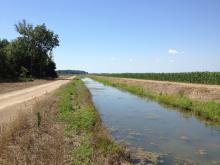Information Possibly Outdated
The information presented on this page was originally released on August 17, 2018. It may not be outdated, but please search our site for more current information. If you plan to quote or reference this information in a publication, please check with the Extension specialist or author before proceeding.
For necessity or fun, water is priceless
STARKVILLE, Miss. -- Summer brings many activities: swimming in pools, recreation in Mississippi’s waterways, washing vehicles after traveling down dirt roads, and irrigating millions of acres of gardens and fields. These and many other activities rely on abundant water.
Putting a dollar value on clean water is difficult. Everyone uses it in their daily lives for drinking and domestic needs, but we also use water through the products we consume. This hidden flow of water is less obvious, so it’s often given less attention when we talk about water conservation.
Consider how much water it takes to grow a pound of cotton. Water is not only used for irrigation, but also to create tractors and other material used in crop production. We can’t overlook the water used to clean the equipment that plants or harvests cotton. It also takes water to mine, refine and transport the diesel fuel consumed in the tractor. In all, it takes 650 gallons of water to grow enough cotton to make one shirt.
In production and manufacturing processes, virtual water can be traded between states and countries through the sale and purchase of products that require water to produce. For example, it takes 32 gallons of water to make a single glass of wine. If a U.S. company sells a bottle of wine to a Canadian consumer, that means a trade of 192 gallons of water to Canada. That amount doesn’t include the water used to make, label or ship the bottle.
Benjamin Franklin once said, “When the well’s dry, we know the worth of water.” The current U.S. economy is valued at more than $100 trillion. If our country’s “well ran dry” -- or we didn’t have access to clean/usable water -- then a fifth of the economy would stop producing.
Of the major U.S. industries relying on water, 41 percent goes toward thermoelectric power and 37 percent toward irrigating crops. The average American uses 176 gallons of water a day.
To help conserve water, try to cut down on your household use by watering the lawn less often, installing low-flow faucets, or getting water- and energy-efficient appliances. Help reduce your indirect or virtual water use by eating more whole fruits, vegetables and grains and by eating fewer manufactured and processed foods. Consider biking to the park instead of driving your car, and consider buying used items before you buy a brand new product.
Next time you turn on that faucet to enjoy a nice refreshing glass of water or to make sweet tea, don’t take it for granted. Human life relies on a clean source of drinking water.
For more information about water conservation, as well as conservation practices for agriculture, contact Beth Baker with the Research and Education to Advance Conservation and Habitat program at Mississippi State University at 662-325-7491 or beth.baker@msstate.edu.

Editor’s Note: Extension Outdoors is a column authored by several different experts in the Mississippi State University Extension Service.






